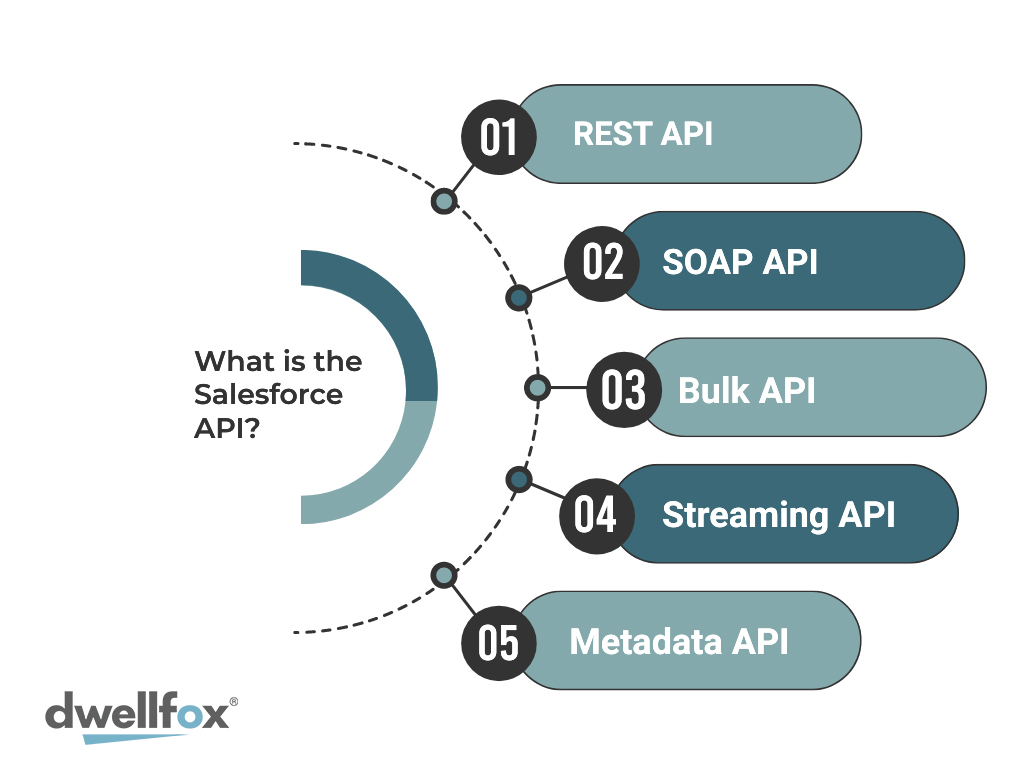Revolutionize Business Operations by Integration of Salesforce APIs
Introduction
In today's fast-paced business world, organizations are constantly striving to improve their operations and stay ahead of the competition. One way to achieve this is by integrating Salesforce APIs into their business processes. Salesforce is a leading CRM platform that offers a wide range of tools and functionalities through its APIs, allowing businesses to streamline their operations and gain valuable insights into their customer behavior.
In this blog, we will explore how the integration of Salesforce APIs can revolutionize business operations by improving sales processes, enhancing marketing efforts, improving customer service, increasing data visibility and analysis, and facilitating collaboration and communication. Let's dive in and explore the power of Salesforce APIs.
What exactly is API?
API stands for Application Programming Interface. An API is a collection of procedures, tools, and protocols for creating software programmes. It specifies how software components should interact with each other, and enables communication between different software systems.
APIs allow developers to access and use specific features or data from a software system without having to understand how the underlying system works. This makes it easier to build new applications or integrate existing ones with other systems.
In the context of Salesforce, APIs allow developers to access and manipulate data stored in Salesforce, and to build applications that interact with the Salesforce platform. The Salesforce APIs provide a wide range of functionalities, including data manipulation, integration with third-party systems, and automation of business processes.
What is the Salesforce API?

Salesforce API is a set of programming instructions and protocols that allow developers to access and manipulate data stored in Salesforce, and to build applications that interact with the Salesforce platform. The Salesforce APIs provide a wide range of functionalities, including data manipulation, integration with third-party systems, and automation of business processes.
Salesforce APIs are available in several forms, including REST API, SOAP API, Bulk API, Streaming API, and Metadata API. Each API serves a specific purpose and provides a different set of functionalities.
1. REST API : The REST API is the most commonly used Salesforce API, and allows developers to access and manipulate Salesforce data using HTTP requests. It supports a variety of data formats, including JSON and XML, and enables developers to build web and mobile applications that interact with Salesforce.
2.SOAP API : The SOAP API is another Salesforce API that uses the SOAP protocol for exchanging information between systems. It supports more complex operations than the REST API, and is often used for integrating with legacy systems or other SOAP-based systems.
3. Bulk API : The Bulk API is designed for handling large volumes of data, and enables developers to insert, update, upsert, or delete records in Salesforce in bulk.
4.Streaming API : The Streaming API is used for real-time data processing, and allows developers to receive notifications when records are created, updated, or deleted in Salesforce.
5. Metadata API : The Metadata API allows developers to access and manipulate the metadata of Salesforce objects, such as fields, page layouts, and workflows.
Overall, Salesforce APIs provide powerful tools and functionalities for developers to build custom applications and integrations that enhance the capabilities of the Salesforce platform.
Capabilities of Salesforce API Integration

Salesforce API integration allows you to connect your Salesforce instance with other systems and applications, enabling you to automate workflows, share data, and streamline business processes. Here are some capabilities of Salesforce API integration:
1. Data synchronization: Salesforce API integration allows you to synchronize data between Salesforce and other systems in real-time or batch mode. This enables you to keep your data consistent across multiple systems and avoid data entry errors.
2. Workflow automation: You can use Salesforce API integration to automate workflows between Salesforce and other systems. For example, you can automatically create a task in Salesforce when a new lead is added to your marketing automation platform.
3. Customization: Salesforce API integration enables you to customize your Salesforce instance to meet your specific business requirements. You can create custom objects, fields, and workflows that are unique to your organization.
4. Analytics and Reporting You can use Salesforce API integration to integrate Salesforce data with other business intelligence tools such as Tableau or Power BI. This enables you to create custom reports and dashboards that combine data from multiple systems.
5. App development Salesforce API integration provides developers with access to a rich set of APIs, enabling them to build custom apps that integrate with Salesforce. This allows you to extend the functionality of Salesforce to meet your specific business needs.
6. Security and compliance: Salesforce API integration provides a secure and compliant way to exchange data between Salesforce and other systems. You can control access to data, monitor data usage, and ensure compliance with regulatory requirements.
How the integration of Salesforce APIs can transform business operations ?
1. Streamlining sales processes
By integrating Salesforce APIs into their sales processes, businesses can automate many of their sales workflows, from lead generation and qualification to closing deals and invoicing. This can significantly improve sales team efficiency and productivity, as well as enhance the overall customer experience.
2. Enhancing marketing efforts
Salesforce APIs can be used to integrate marketing automation tools, allowing businesses to create targeted and personalized marketing campaigns that are highly effective in reaching their target audience. This can result in higher lead generation and conversion rates, as well as better customer engagement and retention.
3. Improving customer service
Salesforce APIs can be used to integrate customer service tools such as chatbots, knowledge bases, and ticketing systems. This can enhance the customer service experience by providing timely and personalized responses to customer inquiries and issues, resulting in higher customer satisfaction levels.
4. Increasing data visibility and analysis
Salesforce APIs can be used to integrate data analytics tools, allowing businesses to gain deeper insights into their operations and customer behavior. This can enable them to make more informed business decisions and optimize their operations for greater efficiency and profitability.
5. Facilitating collaboration and communication
Salesforce APIs can be used to integrate collaboration and communication tools such as video conferencing, team chat, and project management software. This can improve communication and collaboration within teams, as well as between teams and departments, resulting in better coordination and more effective teamwork.
Uses of Some API
1. REST API: The Salesforce REST API provides a lightweight and flexible way to interact with Salesforce data using HTTP requests. Here are some of the common use cases for the REST API:
- Building custom applications You can use the REST API to build custom applications that integrate with Salesforce data. For example, you can build a mobile app that allows users to view and edit their Salesforce records.
- Integrating with third-party systemsYou can use the REST API to integrate Salesforce data with other third-party systems, such as marketing automation platforms or customer support systems. This enables you to automate workflows and share data across systems.
- Data migrationYou can use the REST API to migrate data from other systems into Salesforce, or to extract data from Salesforce for use in other systems.
2. SOAP API: The Salesforce SOAP API provides a more robust and feature-rich interface for accessing Salesforce data compared to the REST API. Here are some of the common use cases for the SOAP API:
- Integration with client applications The SOAP API supports client-side application development using languages like Java or .NET. This makes it easier to develop client-side applications that integrate with Salesforce.
- Asynchronous processingThe SOAP API allows you to perform asynchronous processing of data, which means you can send large amounts of data to Salesforce and receive a response when the processing is complete.
- Custom metadata managementThe SOAP API allows you to access and manage custom metadata in Salesforce. This is useful when you need to create or update custom objects or fields in Salesforce.
Conclusion
The integration of Salesforce APIs can revolutionize business operations by streamlining processes, automating workflows, and providing deeper insights into data. By connecting Salesforce with other systems and applications, businesses can create a unified data ecosystem that enables them to make better decisions and improve customer experiences.
Salesforce APIs such as REST API and SOAP API provide a flexible and powerful way to interact with Salesforce data and integrate with other systems. With REST API, businesses can build custom applications, integrate with third-party systems, migrate data, create custom reports, and automate workflows. SOAP API provides a more robust interface for more complex integrations, client-side applications, and custom metadata management.
By leveraging the power of Salesforce APIs, businesses can achieve a range of benefits including increased productivity, reduced errors, better customer experiences, and improved decision-making. As businesses continue to evolve and adapt to changing market conditions, the integration of Salesforce APIs will play an increasingly important role in driving innovation and growth.
Related Blogs

Inspiring Digital Transformation Examples to Guide Your Strategy...
Angular, a popular JavaScript framework, provides tools for building complex web applications, while AWS offers a wide ...
Read article
Unlock the Secrets of Remote Working to Drive Productivity and...
Discover the secrets of successful remote working, and how it can increase both productivity and access to a global pool ...
Read article
How Can Extended Reality Be Used For Product Visualisation?
XR stands for Extended Reality, whereas product visualisation refers to the process of creating 3D renderings. The blog carries ...
Read article
